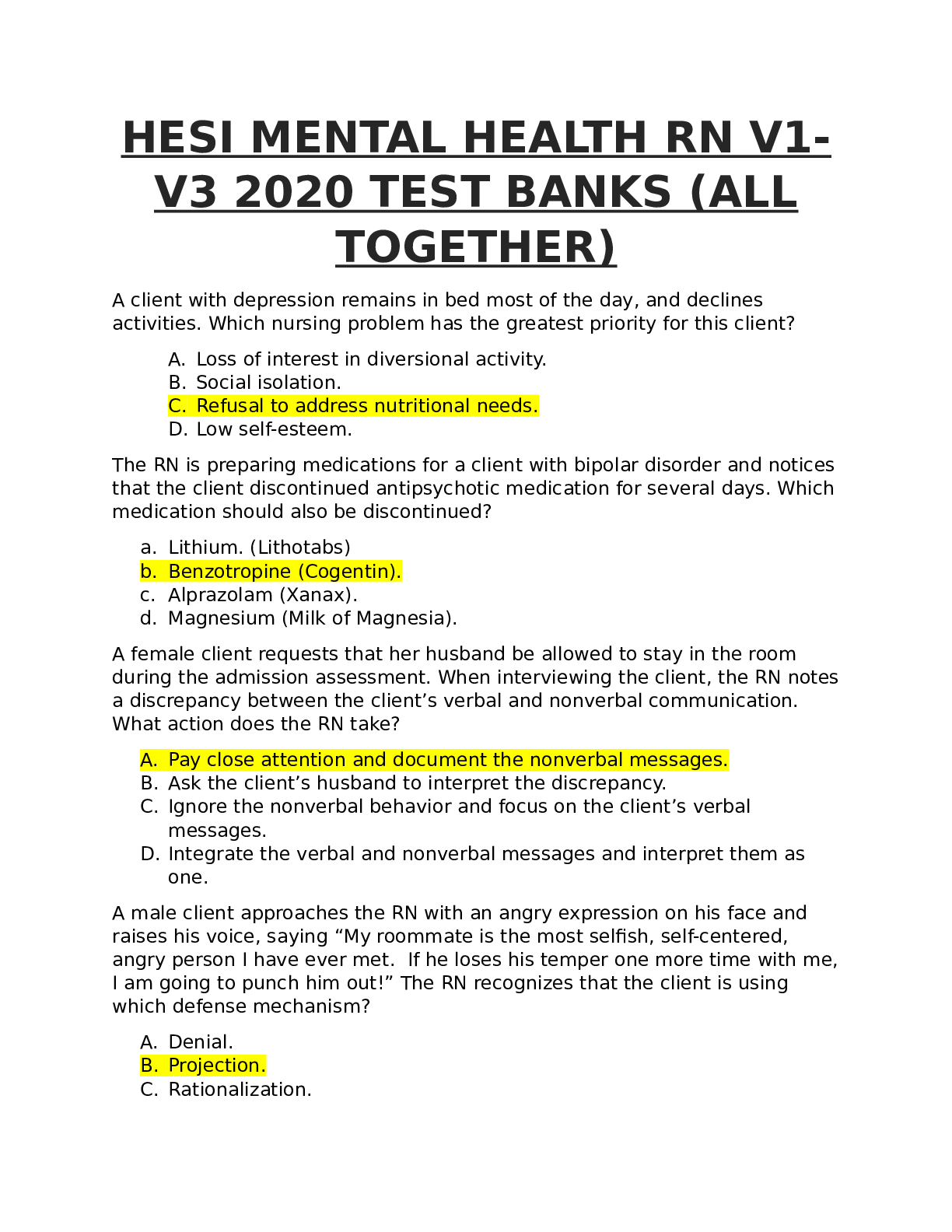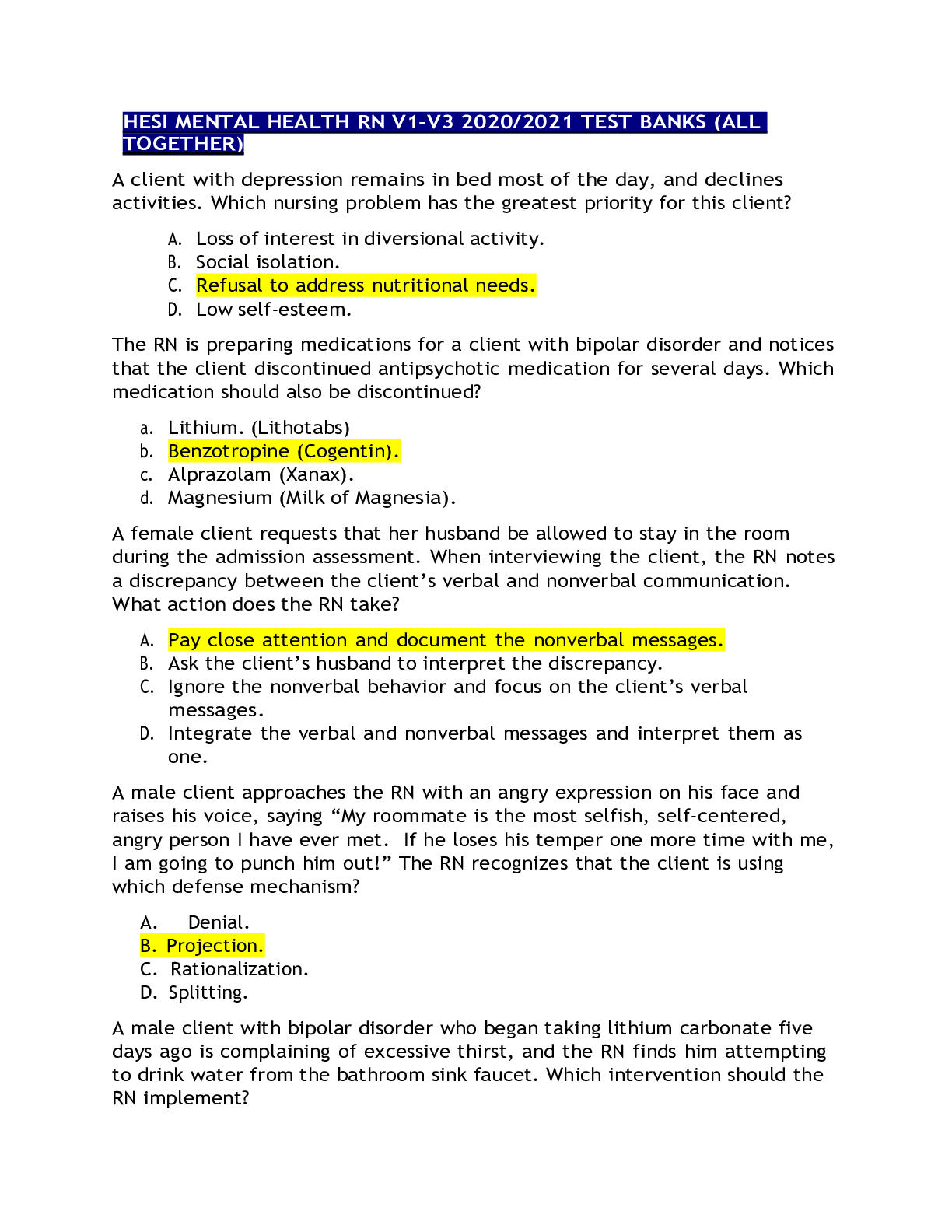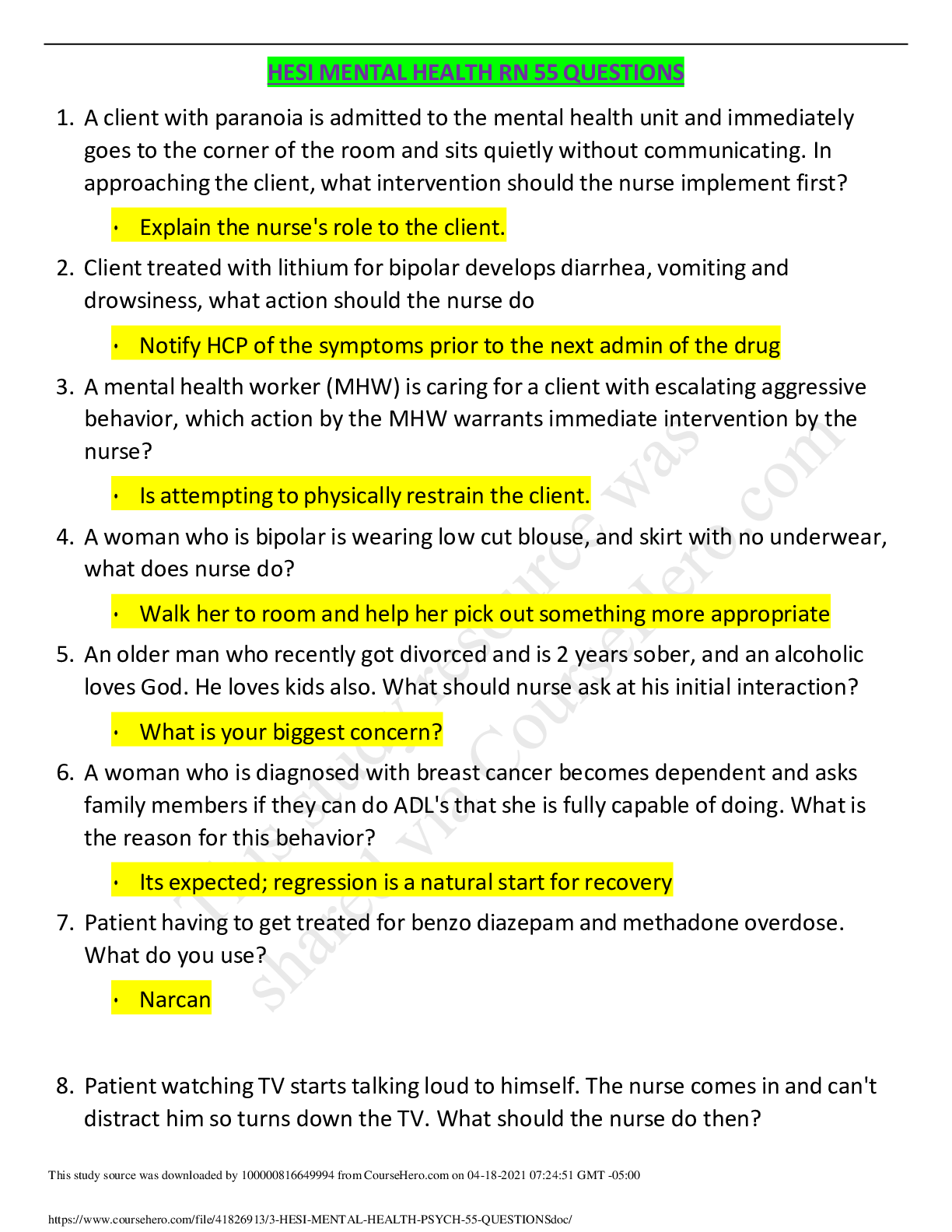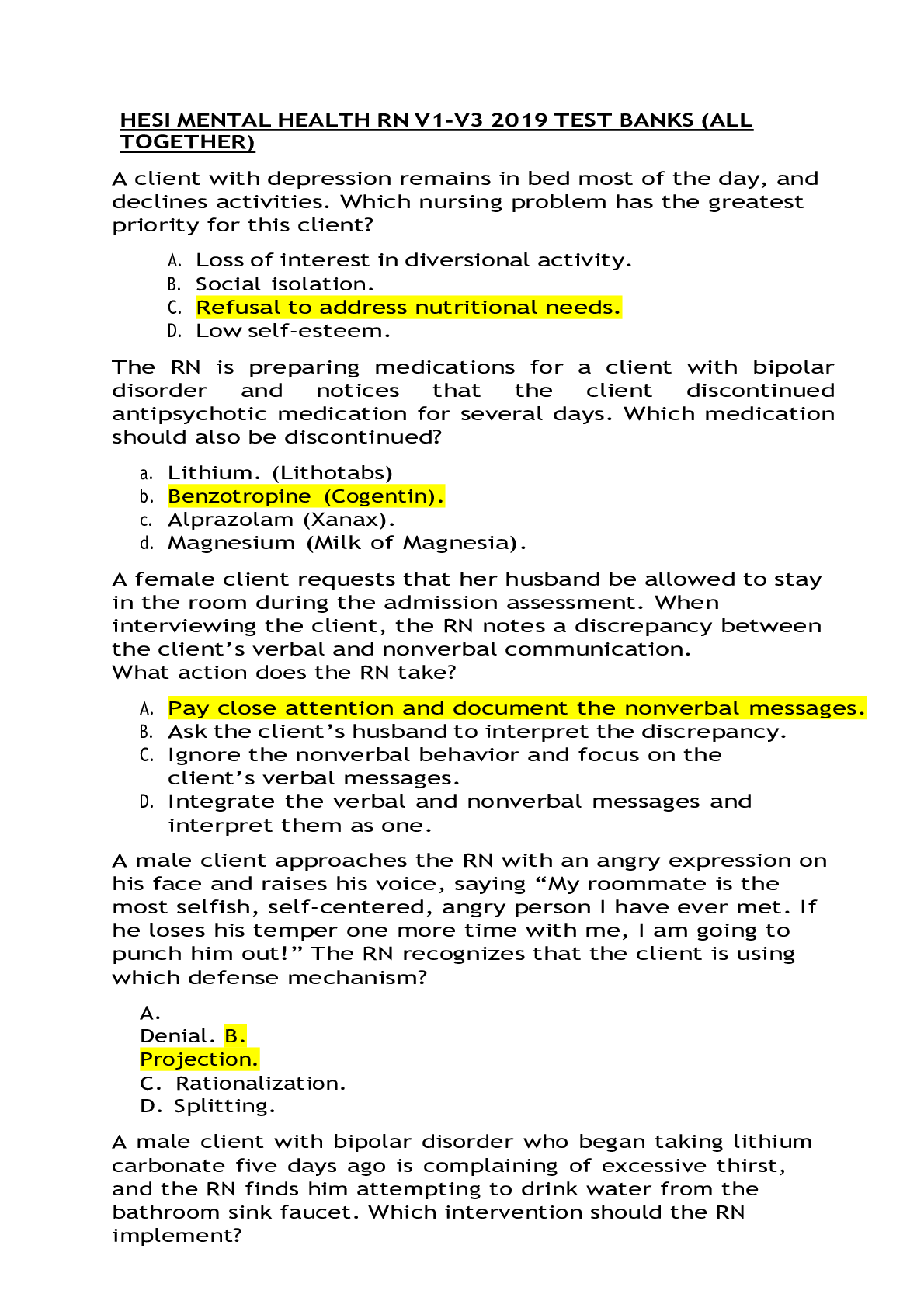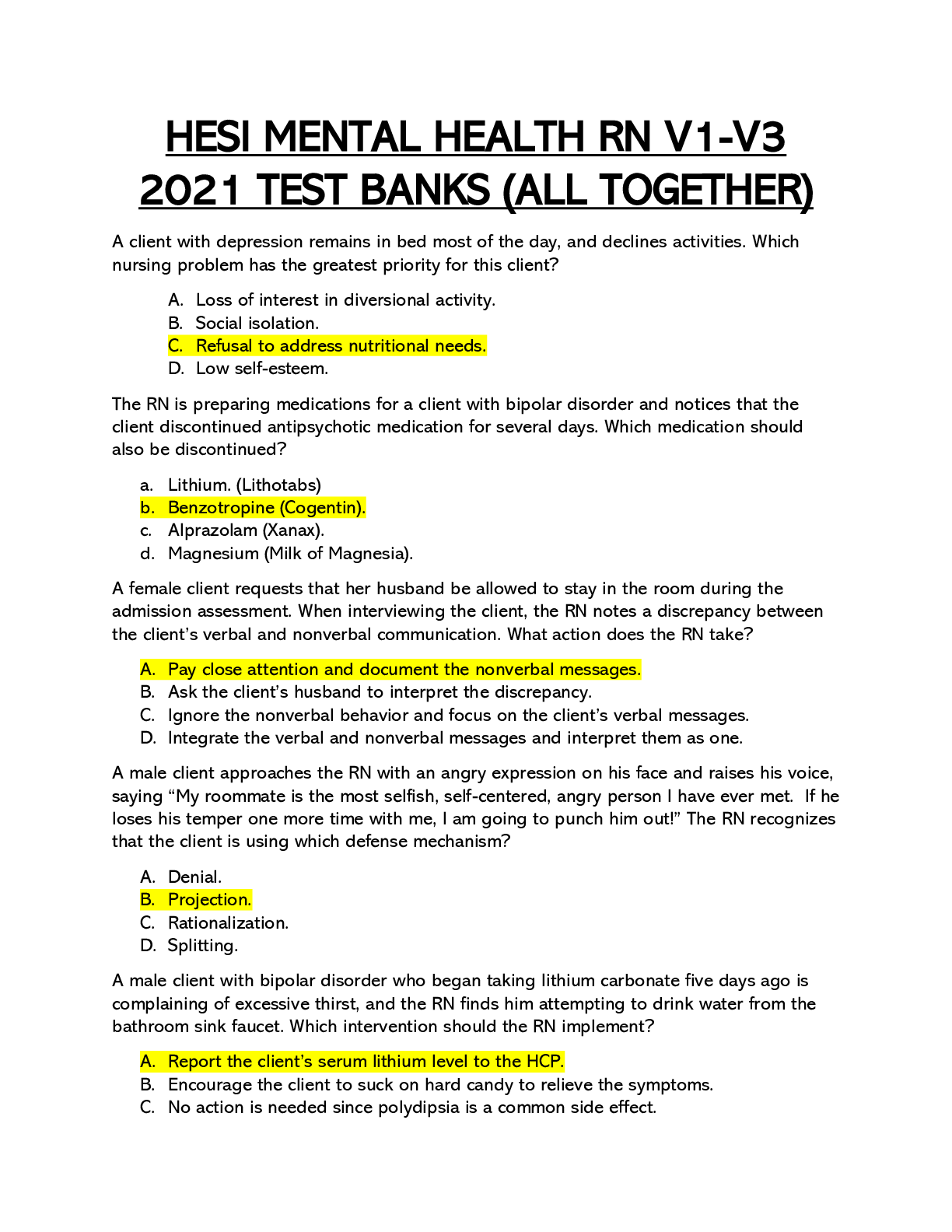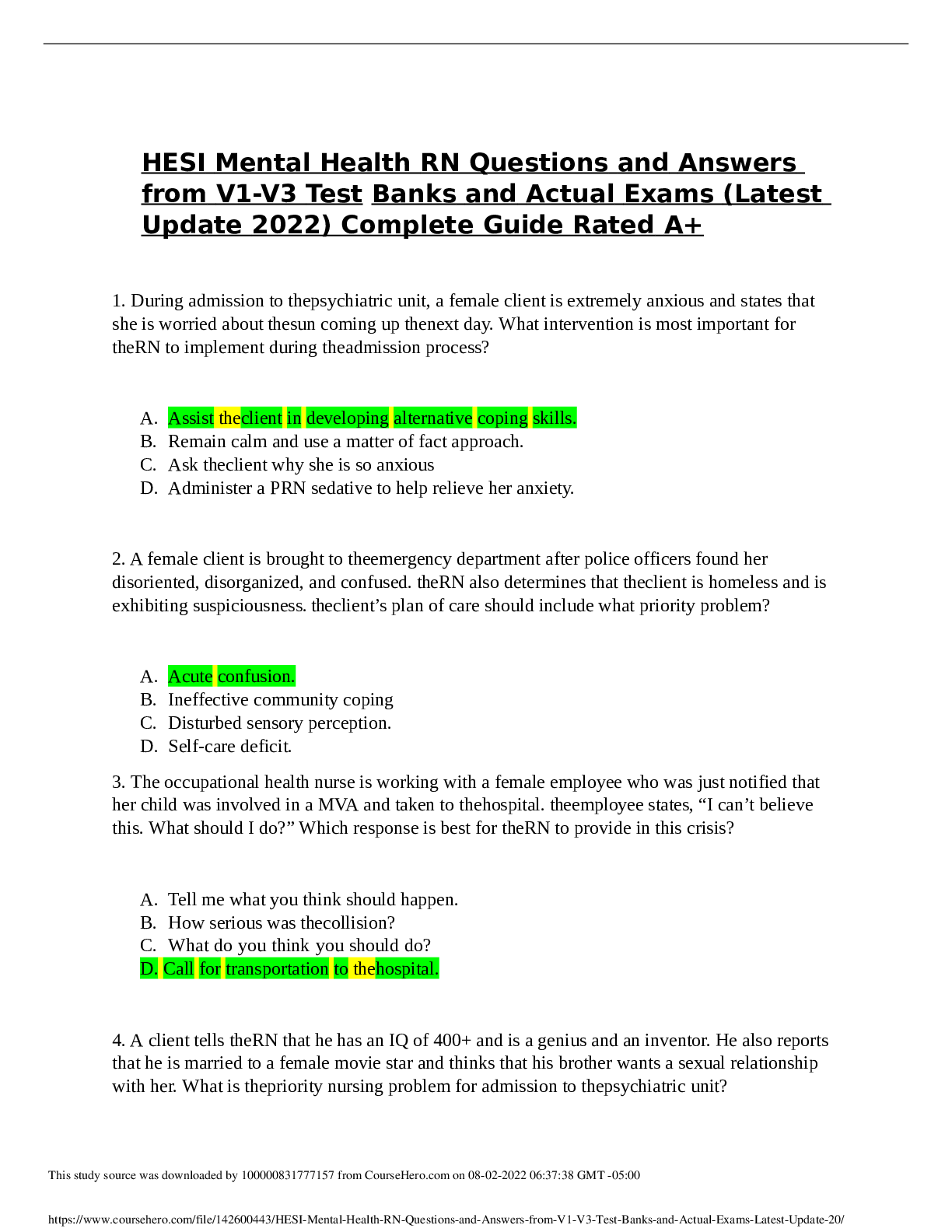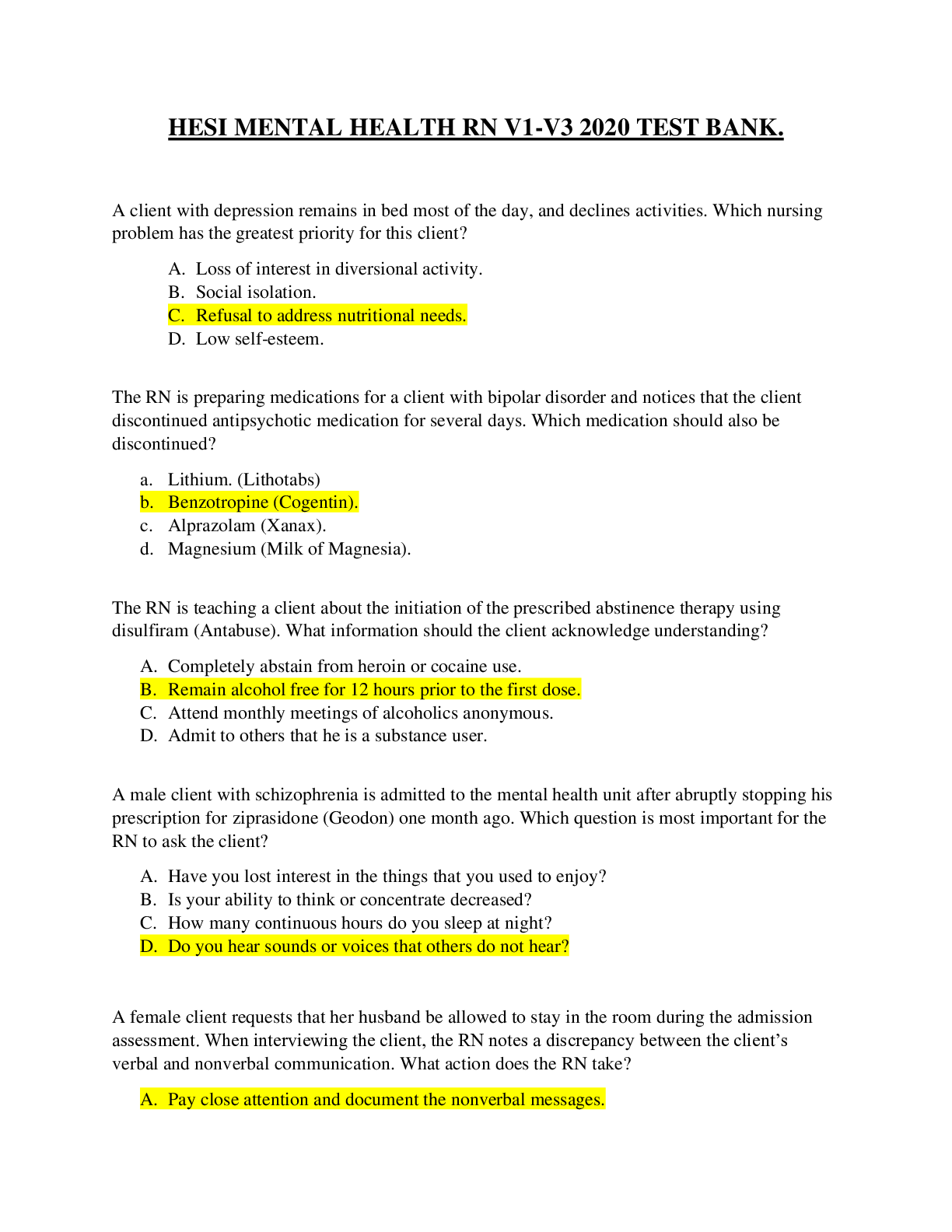Health Care > EXAM > Hesi-mental-health-rn-v1-v3-2020- test bank for 2020-2021/HESI MENTAL HEALTH RN V1-V3 2020/2021 TEST (All)
Hesi-mental-health-rn-v1-v3-2020- test bank for 2020-2021/HESI MENTAL HEALTH RN V1-V3 2020/2021 TEST BANK
Document Content and Description Below
A client with depression remains in bed most of the day, and declines activities. Which nursing problem has the greatest priority for this client? A. Loss of interest in diversional activity. B. So... cial isolation. C. Refusal to address nutritional needs. D. Low self-esteem. The RN is preparing medications for a client with bipolar disorder and notices that the client discontinued antipsychotic medication for several days. Which medication should also be discontinued? a. Lithium. (Lithotabs) b. Benzotropine (Cogentin). c. Alprazolam (Xanax). d. Magnesium (Milk of Magnesia). A female client requests that her husband be allowed to stay in the room during the admission assessment. When interviewing the client, the RN notes a discrepancy between the client’s verbal and nonverbal communication. What action does the RN take? A. Pay close attention and document the nonverbal messages. B. Ask the client’s husband to interpret the discrepancy. C. Ignore the nonverbal behavior and focus on the client’s verbal messages. D. Integrate the verbal and nonverbal messages and interpret them as one. A male client approaches the RN with an angry expression on his face and raises his voice, saying “My roommate is the most selfish, self-centered, angry person I have ever met. If he loses his temper one more time with me, I am going to punch him out!” The RN recognizes that the client is using which defense mechanism? A. Denial. B. Projection. C. Rationalization. D. Splitting. A male client with bipolar disorder who began taking lithium carbonate five days ago is complaining of excessive thirst, and the RN finds him attempting to drink water from the bathroom sink faucet. Which intervention should the RN implement? A. Report the client’s serum lithium level to the HCP. B. Encourage the client to suck on hard candy to relieve the symptoms. C. No action is needed since polydipsia is a common side effect. D. Tell the client that drinking from the faucet is not allowed. The RN is teaching a client about the initiation of the prescribed abstinence therapy using disulfiram (Antabuse). What information should the client acknowledge understanding? A. Completely abstain from heroin or cocaine use. B. Remain alcohol free for 12 hours prior to the first dose. C. Attend monthly meetings of alcoholics anonymous. D. Admit to others that he is a substance user. A male client with schizophrenia is admitted to the mental health unit after abruptly stopping his prescription for ziprasidone (Geodon) one month ago. Which question is most important for the RN to ask the client? A. Have you lost interest in the things that you used to enjoy? B. Is your ability to think or concentrate decreased? C. How many continuous hours do you sleep at night? D. Do you hear sounds or voices that others do not hear? During an annual physical by the occupational RN working in a corporate clinic, a male employee tells the RN that is high-stress job is causing trouble in his personal life. He further explains that he often gets so angry while driving to and from work that he has considered “getting even” with other drivers. How should the RN respond? A. “Anger is contagious and could result in major confrontation.” B. “Try not to let your anger cause you to act impulsively.” C. “Expressing your anger to a stranger could result in an unsafe situation.” D. “It sounds as if there are many situations that make you feel angry.” A client who has agoraphobia (a fear of crowds) is beginning desensitization with the therapist, and the RN is reinforcing the process. Which intervention has the highest priority for this client’s plan of care? A. Encourage substitution of positive thoughts and negative ones. B. Establish trust by providing a calm, safe environment. C. Progressively expose the client to larger crowds. D. Encourage deep breathing when anxiety escalates in a crowd. Which nursing actions are likely to help promote the self-esteem of a male client with modern depression? A. Ask the client what his long term goals are. B. Discuss the challenges of his medical condition. C. Include the client in determining treatment protocol. D. Encourage the client to engage in recreational therapy. E. Provide opportunities for the client to discuss his concerns. A male client is admitted to the psychiatric unit for recurrent negative symptoms of chronic schizophrenia and medication adjustment of Risperidone (Risperdal). When the client walks to the nurse’s station in a laterally contracted position, he states that something has made his body contort into a monster. What action should the RN take? A. Medicate the client with the prescribed antipsychotic thioridazine (Mellaril). B. Offer the client a prescribed physical therapy hot pack for muscle spasms. C. Direct client to occupational therapy to distract him from somatic complaints. D. Administer the prescribed anticholinergic benztropine (Cogentin) for dystonia. A mental health worker is caring for a client with escalating aggressive behavior. Which action by the MHW warrant immediate intervention by the RN? A. Is attempting to physically restrain the patient. B. Tells the client to go to the quiet area of the unit. C. Is using a loid voice to talk to the client. D. Remains at a distance of 4 feet from the client. A client on the mental health unit is becoming more agitated, shouting at the staff, and pacing in the hallway. When the PRN medication is offered, the client refuses the medication and defiantly sits on the floor in the middle of the unit hallway. What nursing intervention should the RN implement first? A. Transport of the client to the seclusion room. B. Quietly approach the client with additional staff members. C. Take other clients in the area to the client lounge. D. Administer medication to chemically restrain the patient. A client is admitted to the mental health unit and reports taking extra antianxiety medication because, “I’m so stressed out. I just want to go to sleep.” The RN should plan one-on-one observation of the client based on which statement? A. “What should I do? Nothing seems to help.” B. “I have been so tired lately and needed to sleep.” C. “I really think that I don’t need to be here.” D. “I don’t want to walk. Nothing matters anymore.” A male hospital employee is pushed out the way by a female employee because of an oncoming gurney. The pushed employee becomes very angry and swings at the female employee. Both employees are referred for counseling with the staff psychiatric RN. Which factor in the pushed employee’s history is most related to the reaction that occurred? A. Is worried about losing his job to a woman. B. Tortured animals as a child. C. Was physically abused by his mother. D. Hates to be touched by anyone. The RN documents the mental status of a female client who has been hospitalized for several days by court order. The client states, “I don’t need to be here” and tells the RN that she believes the television talks to her. The RN should document these assessment findings in which section of the mental status exam/ A. Level of concentration. B. Insight and judgement. C. Remote memory. D. Mood and affect. A client is admitted to the mental health unit reports shortness of breath and dizziness. The client tells the RN, “I feel like I’m going to die”. Which nursing problem should the RN include in this client’s plan of care? A. Mood disturbance. B. Moderate anxiety. C. Altered thoughts. D. Social isolation. A female client who is wearing dirty clothes and has foul body odor, comes to the clinic reporting feeling scared because she is being stalked. What action is most important for the RN to take? A. Offer the client a safe place to relax before interviewing her. B. Ask the client to describe why she is being stalked. C. Recommend that the client talk with a social worker. D. Assure the client that the HCP will see her today. The RN leading a group session of adolescent clients gives the members a handout about anger management. One of the male clients is fidgety, interrupts peers when they try and talk, and talks about his pets at home. What nursing action is best for the RN to take? A. Explore the client’s feelings about his pets and home life. B. Encourage his peers to help involve him in the activity. C. Give the client permission to leave and return in 10 minutes. D. Redirect him by encouraging him to read from the handout. A male adolescent was admitted to the unit two days ago for depression. When the mental health RN tries to interview the client to establish rapport, he becomes very irritated and sarcastic. Which action is best for the RN to take? A. Report the behavior to the next shift. B. Offer to play a game of cards with the client. C. Document the behavior in the chart. D. Plan to talk with the client the next day. A male adult is admitted because of an acetaminophen (Tylenol) overdose. After transfer to the mental health unit, the client is told he has liver damage. Which information is most important for the nurse to include in the client's discharge plan? A. Do not take any over the counter meds. B. Eat a high carb, low fat, low protein diet. C. Call the crisis hotline if feeling lonely. D. Avoid exposure to large crowds. After receiving treatment for anorexia, a student asks the school RN for permission to work in the school cafeteria as part of the school’s work study program. What action should the RN take? A. Refer the student to a psychiatrist for further discussion. B. Recommend assignment to the receptionist’s office. C. Suggest that student work in the athletic department. D. Determine the parent’s opinion of the work assignment. The Rn accepts a transfer to the metal health unit and understands that the client is distractible and is exhibiting a decreased ability to concentrate. The RN only has 15 minutes to talk to the client. To develop treatment plan for this client, which assessment is most important for the RN to obtain? A. Motivation of treatment. B. History of substance use. C. Medication compliance. D. Mental status examination. A male client who recently lost a loved one arrives at the mental health center and tells the RN he is no longer interested is his usual activities and has not slept for several days. Which priority nursing problem should the RN include in the client’s plan of care? A. Risk for suicide. B. Sleep deprivation. C. Situational low self-esteem. D. Social isolation. A male client with long history of alcohol dependency arrives in the emergency department describing the feelings of bugs crawling on his body. His blood pressure is 170/102, his pulse rate is 110 bpm, and is blood alcohol level is 0mg/dL. Which prescription should the RN administer? A. Haloperidol (Haldol). B. Thiamine (Vitamin B1). C. Diphenhydramine (Benadryl). D. Lorazepam (Ativan). A client who refuses antipsychotic medications disrupts group activities, talks with nonsensical words and wanders into client’s rooms. The RN decides that the client needs constant observation based on which of these assessment findings? A. Wanders into the clients rooms. B. Refuses antipsychotic medications. C. Talks with nonsensical words. D. Disrupts group activities. A client with schizophrenia explains that she has 20 children and then very seriously points to the RN and explains that she is one of them. What is the most therapeutic response for the RN to provide/ A. “Let’s go ask another RN is this is true.” B. “My name tag shows that I am a RN here.” C. “I can’t possibly be one if your children.” D. “I know that you don’t have 20 children.” A high school girl reveals to the high school RN that she has been engaging in self-induced vomiting as weight-control measure. Which initial assessment should the RN focus on with this adolescent? A. National percentile of weight and height. B. Frequency of bingeing and purging behaviors. C. Perceptions of family and social relationships. D. School grades and extracurricular activities. Narcan was administered to an adult client following a suicide attempt with an overdose of hydrocodone bitartrate (Vicodin). Within 15 minutes, the client is alert and oriented. In planning nursing care, which intervention has the highest priority at this time? A. Encourage the client to increase fluid intake. B. Obtain the client’s serum Vicodin level. C. Observe the client for further narcotic effects. D. Determine the client’s reason for attempting suicide. Following surgery, a male client with antisocial personality disorder frequently requests that a specific RN be assigned to is care and is belligerent when another RN is assigned. What action should the charge RN implement? A. Reassure the client that his request will be met whenever possible. B. Advise the client that assignments are not based on the client’s request. C. Ask the client to explain why he constantly requests the RN. D. Encourage the client to verbalize his feelings about the RN. When preparing to administer a prescribed medication to a homeless male at a community clinic, the client tells the RN that he usually takes a different dosage. What action should the RN take? A. Tell him to take the medication then verify the dosage at the next healthcare team meeting. B. Withhold the medication until the dosage can be confirmed. C. Inform him that he may refuse the medication and document whether or not he takes it. D. Explain to the client that the dosage has been changed. The nurse orients a female client with depression to the new room on the mental health unit. The client states “It seems strange that I don’t have a T.V in my room.” Which statement would be best for the RN to provide? A. “You can watch T.V as much as you want outside of your room.” B. “Sometimes clients feel like the T.V is sending them messages.” C. “It’s important to be out of you room and talking to others.” D. “Watching T.V is a passive activity and we want you to be active.” A client admitted with a closed head injury after a fall has a blood alcohol level of 0.28 (28%) and is difficult to arouse. Which intervention during the first 6 hours following admission should the RN identify as the priority? A. Give lorazepam (Ativan) PRN for signs of withdrawal. B. Administer disulfiram (Antabuse) immediately. C. Place in a side lying position with head of bed elevated. D. Provide thiamine and folate supplements as prescribed. The RN is completing the admission assessment of an underweight adolescent who is admitted to a psychiatric unit with a diagnosis of depression. Which finding requires notification to the HCP? A. Potassium level of 2.9 mEq/dl. B. Blood pressure of 110/70 mmHg. C. WBC of 10,000mm^3. D. Body mass index of 21. The Rn is planning client teaching for a 35-year-old client with alcoholic cirrhosis. Which self-care measure should the RN em [Show More]
Last updated: 1 year ago
Preview 1 out of 42 pages
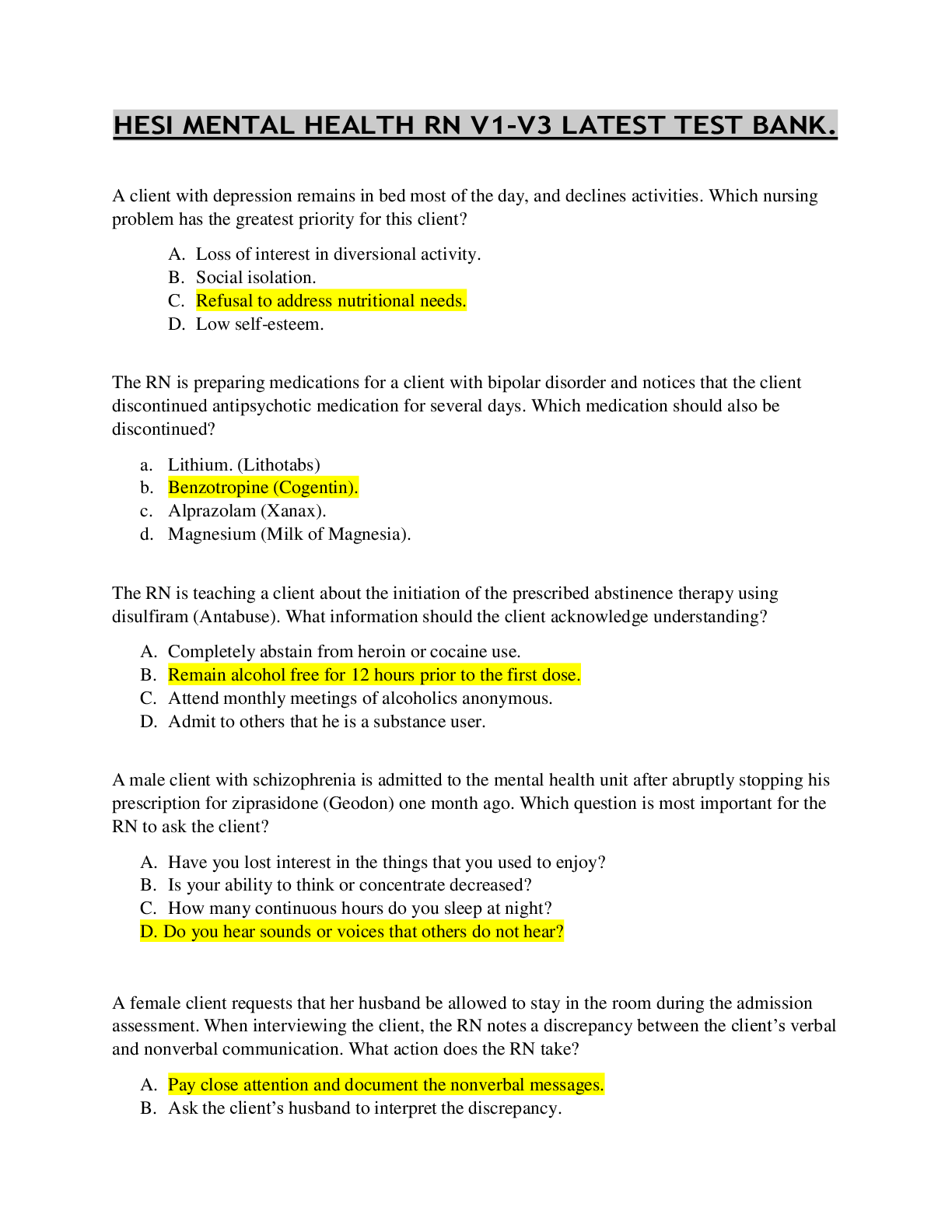
Reviews( 0 )
Document information
Connected school, study & course
About the document
Uploaded On
Jul 21, 2022
Number of pages
42
Written in
Additional information
This document has been written for:
Uploaded
Jul 21, 2022
Downloads
0
Views
35


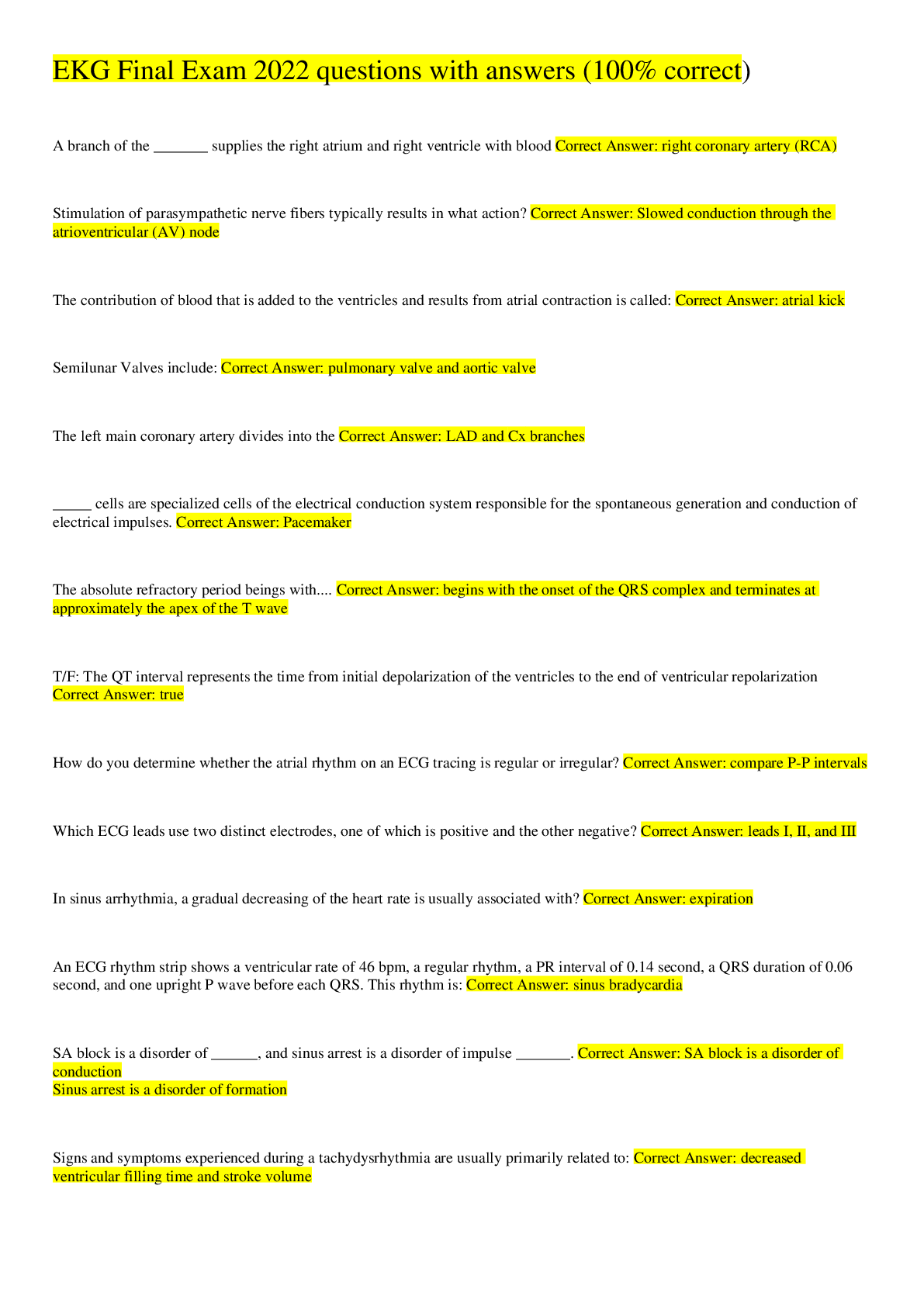
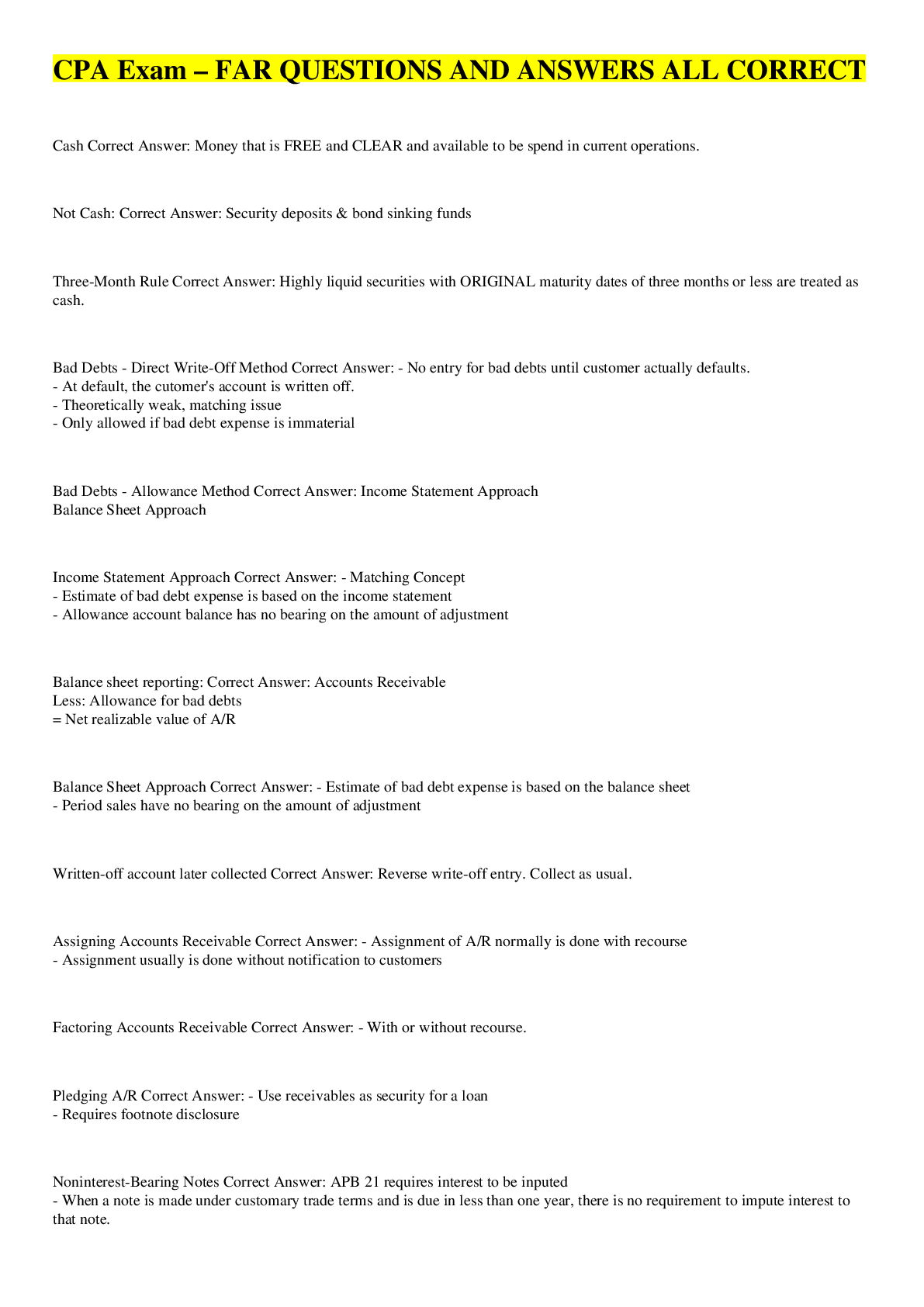
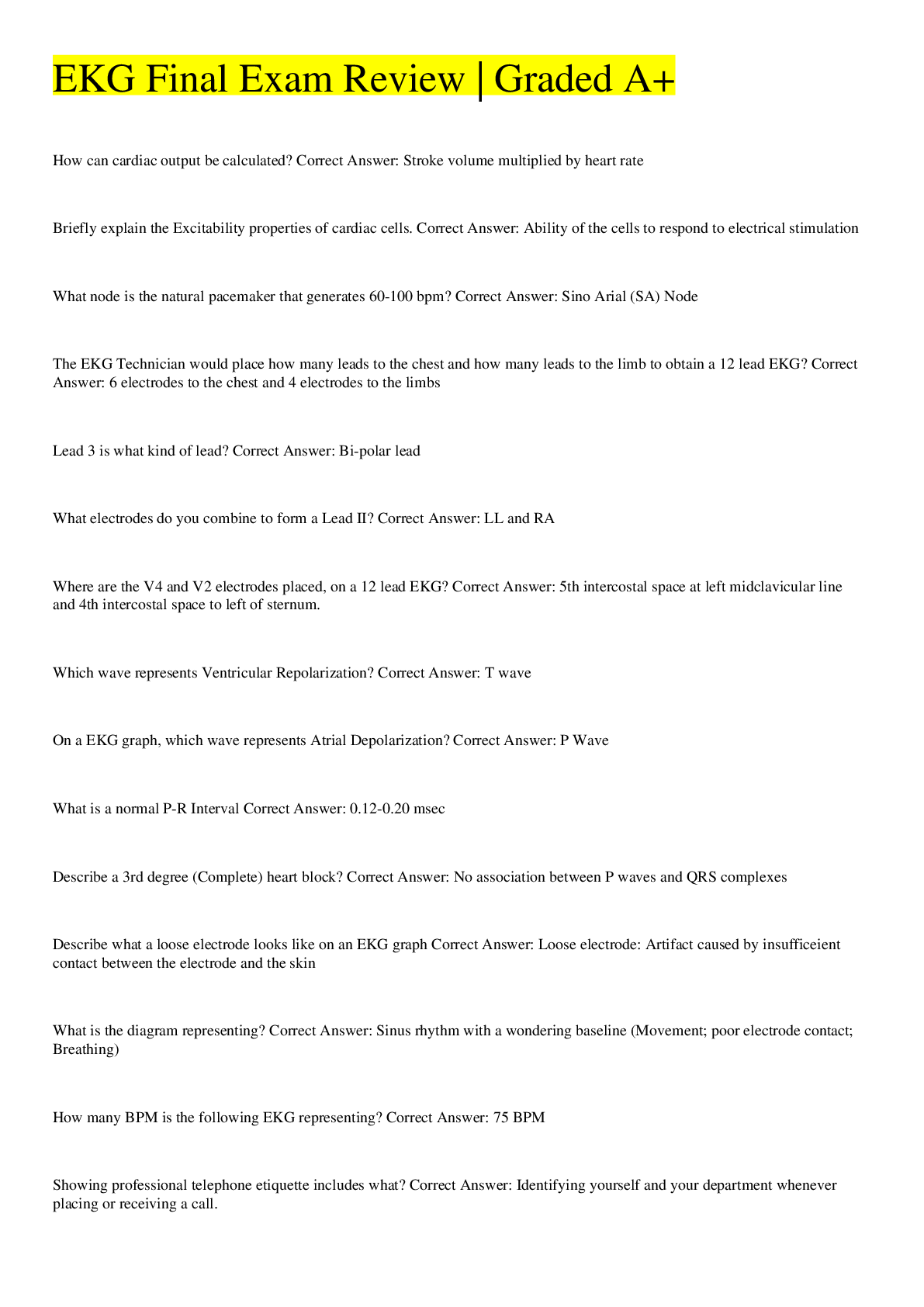
.png)

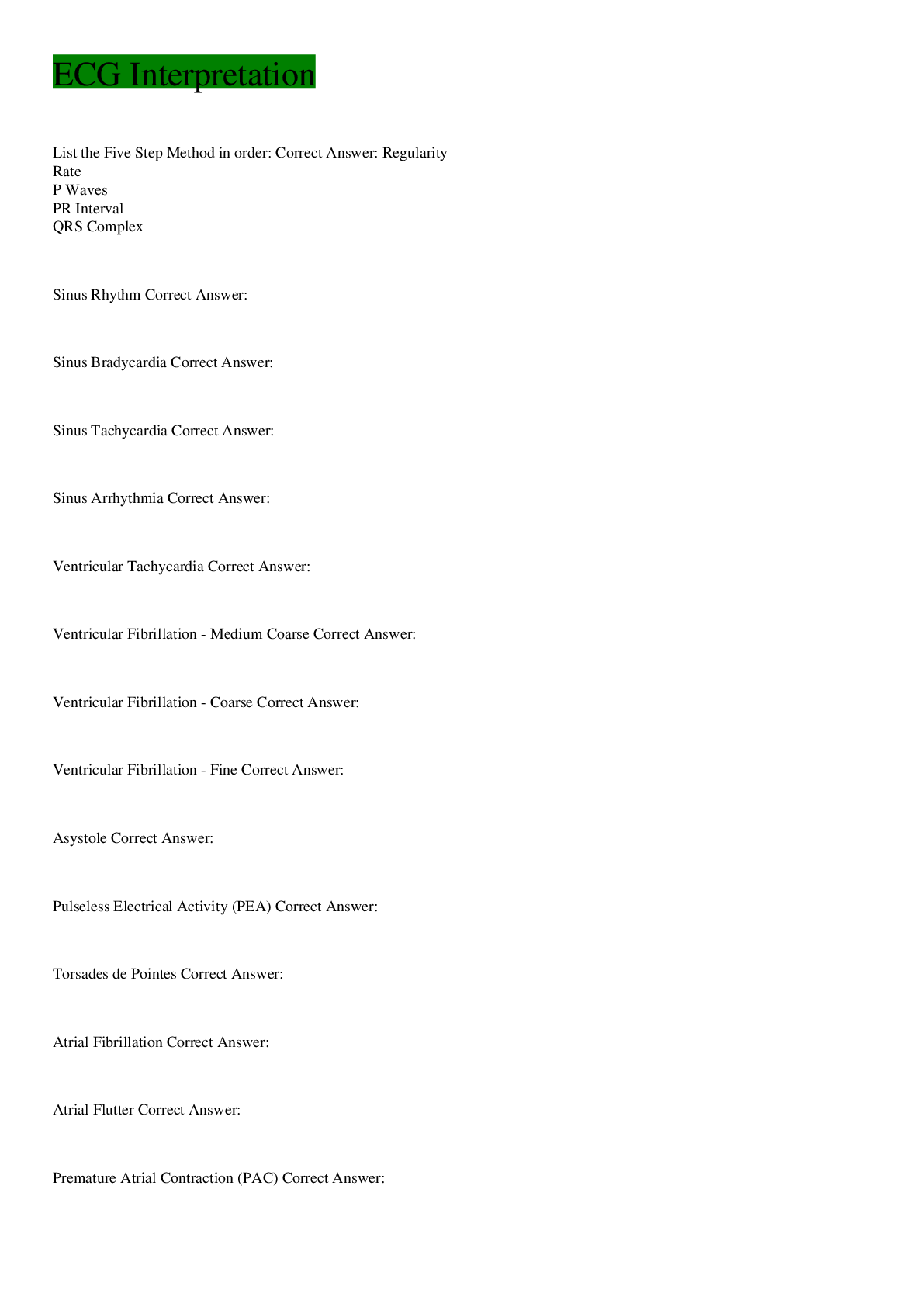
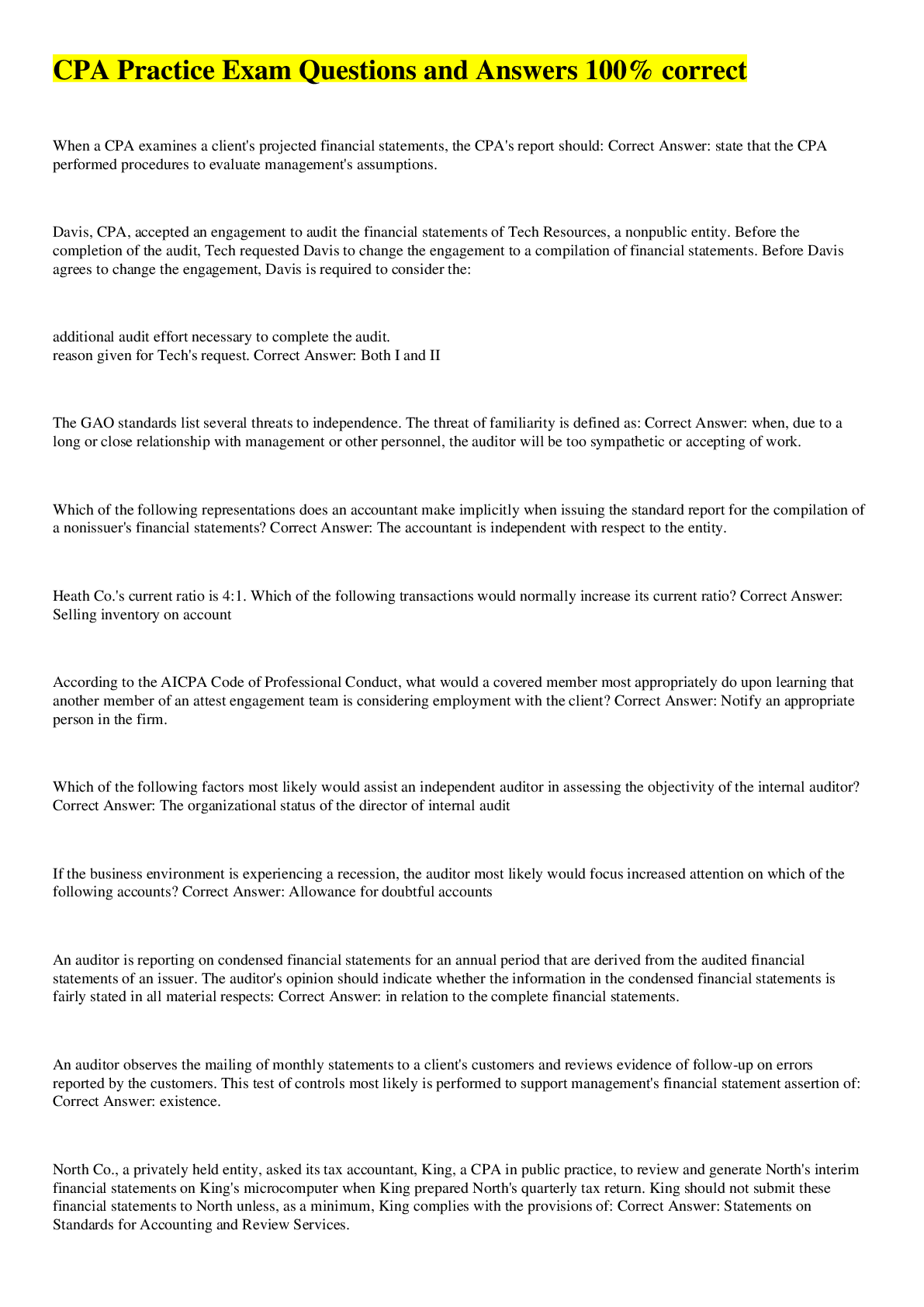
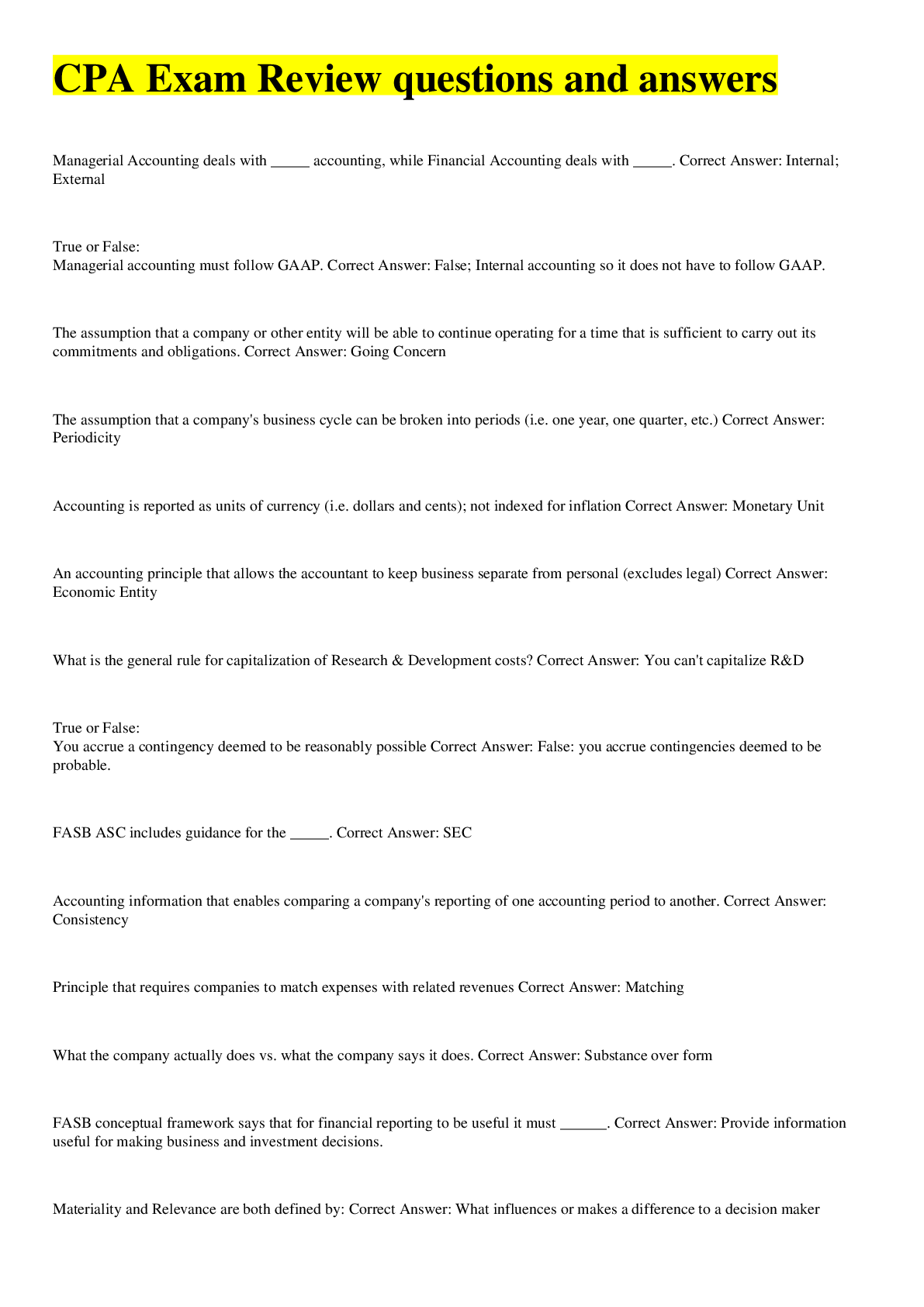


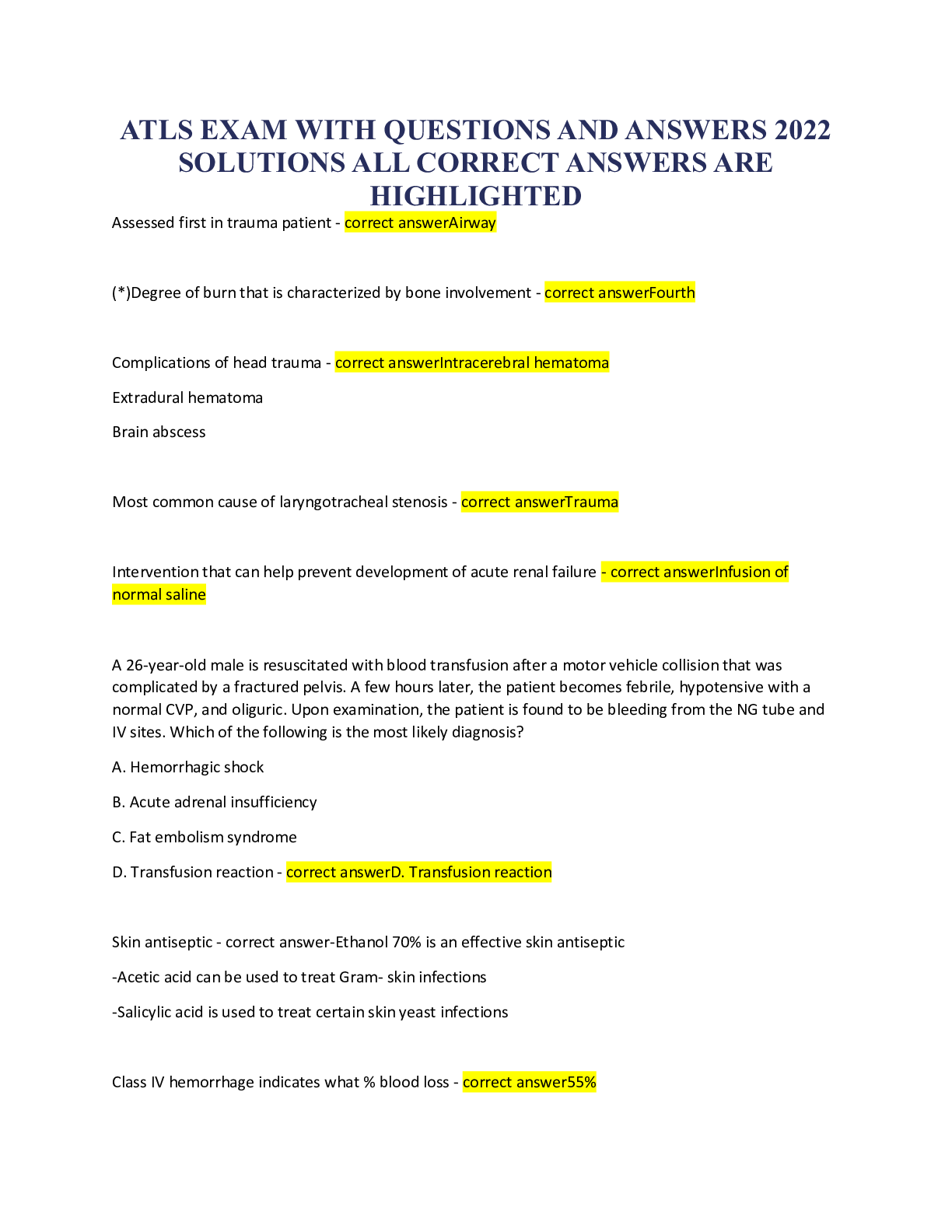

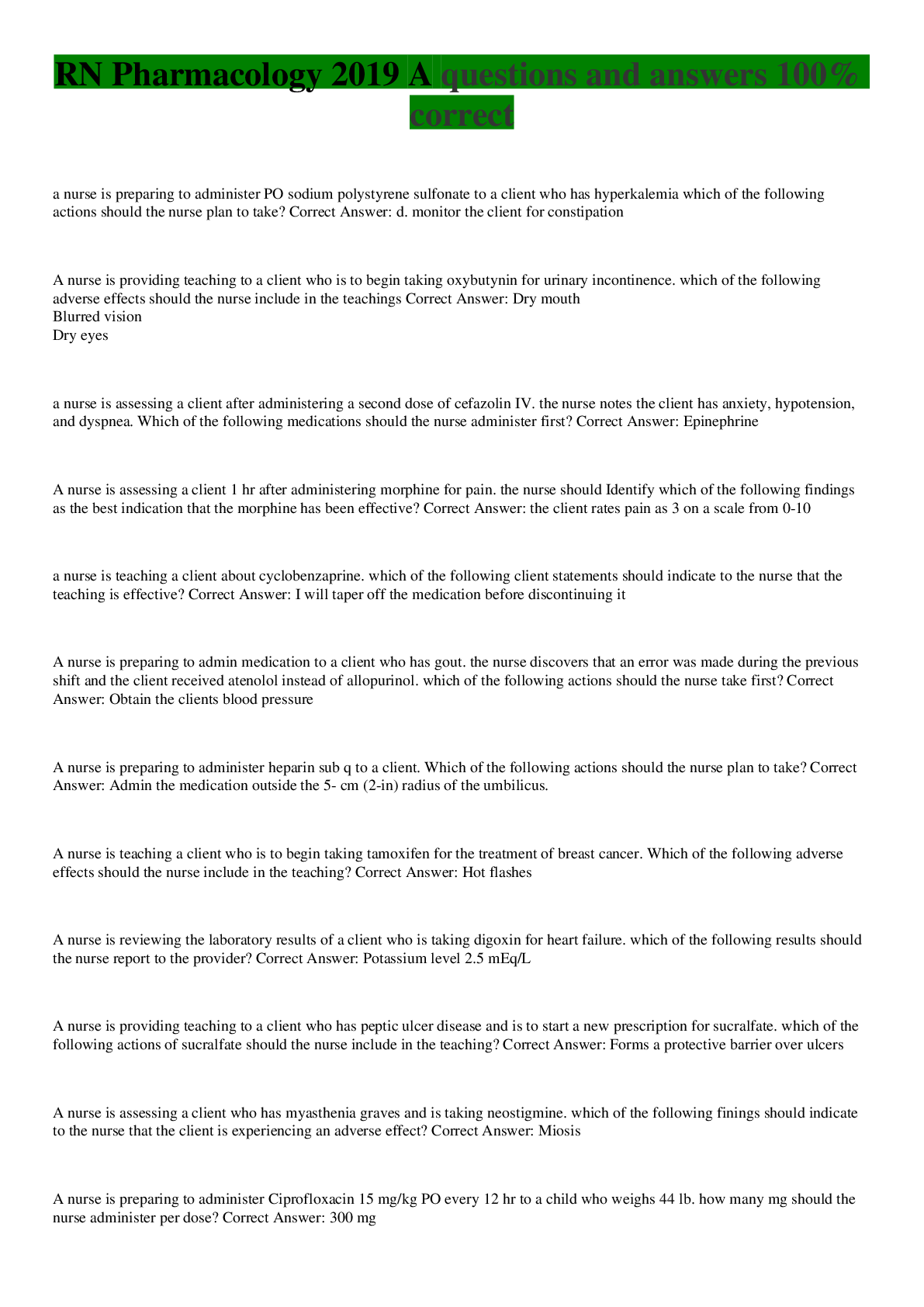
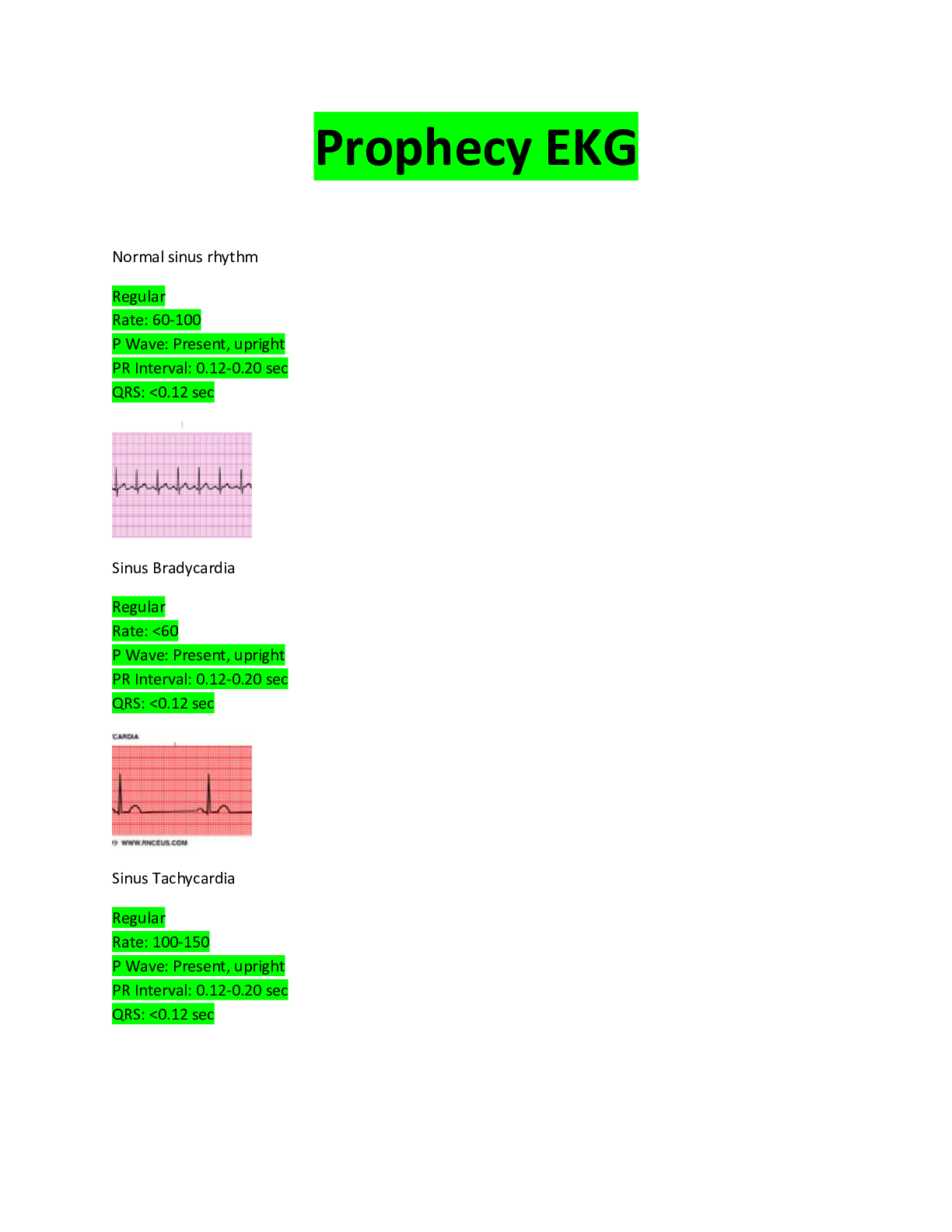
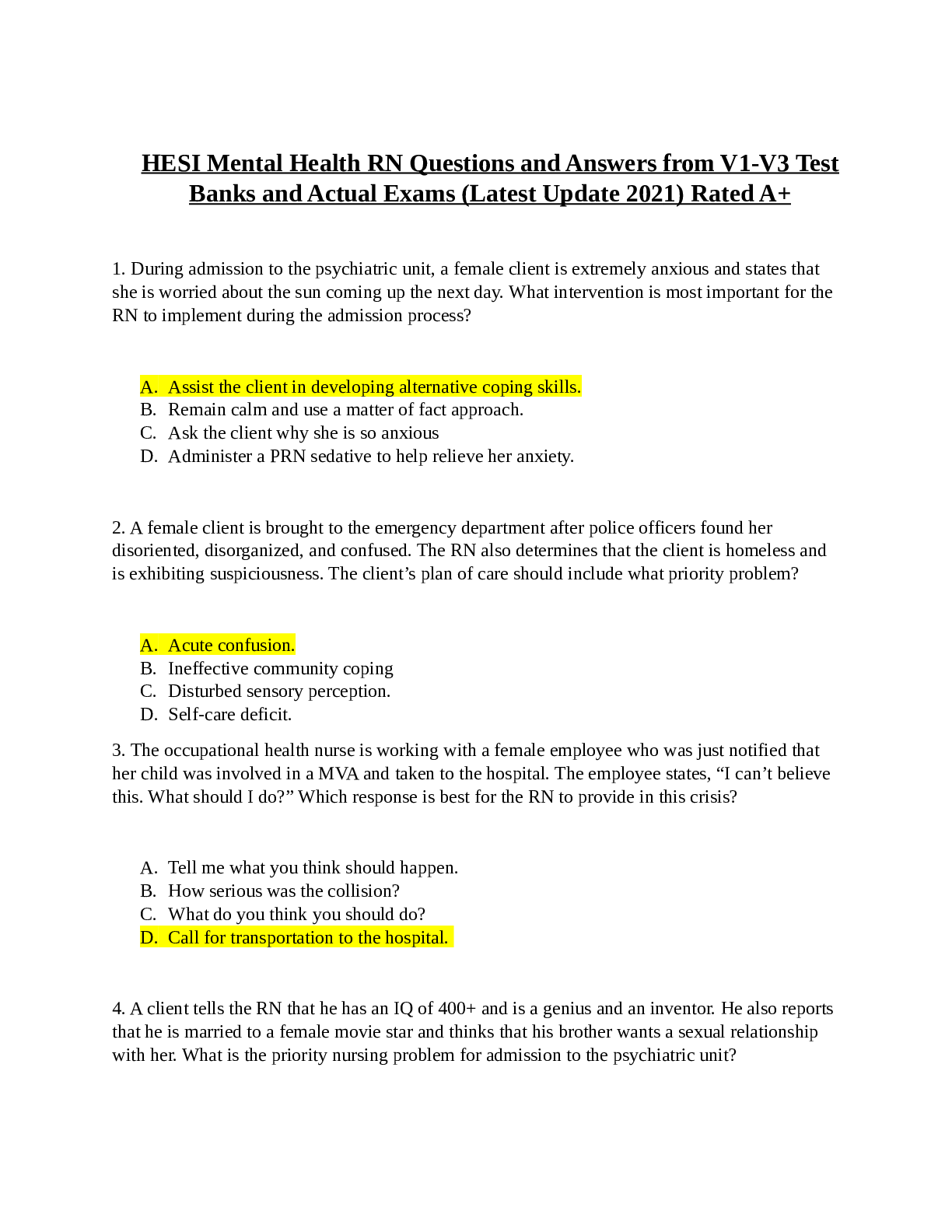
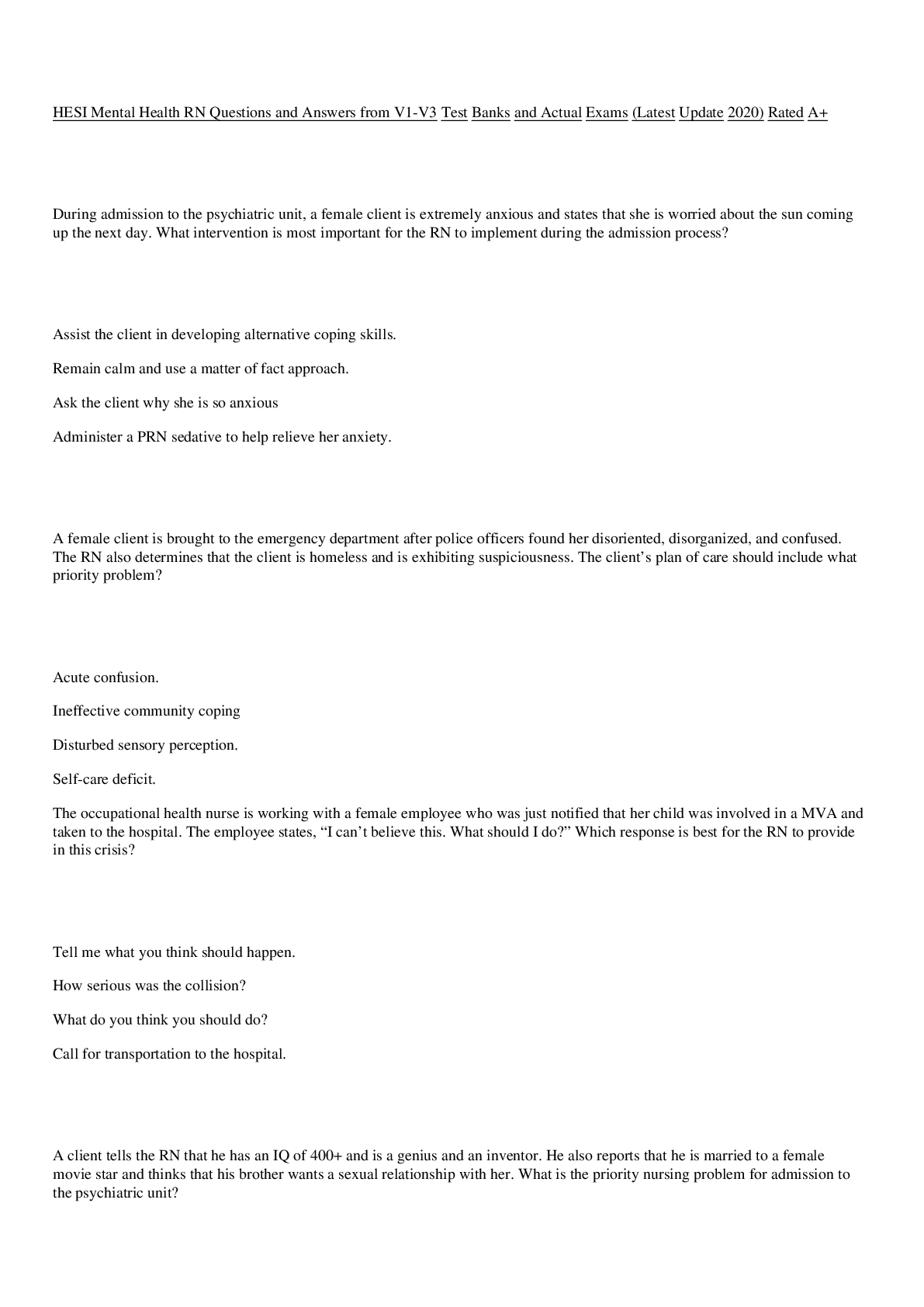
 Rated A+.png)
